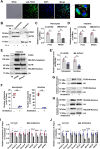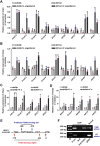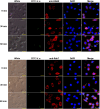FOXO regulates the expression of antimicrobial peptides and promotes phagocytosis of hemocytes in shrimp antibacterial immunity
- PMID: 33798239
- PMCID: PMC8046353
- DOI: 10.1371/journal.ppat.1009479
FOXO regulates the expression of antimicrobial peptides and promotes phagocytosis of hemocytes in shrimp antibacterial immunity
Abstract
Invertebrates rely on innate immunity, including humoral and cellular immunity, to resist pathogenic infection. Previous studies showed that forkhead box transcription factor O (FOXO) participates in mucosal immune responses of mammals and the gut humoral immune regulation of invertebrates. However, whether FOXO is involved in systemic and cellular immunity regulation in invertebrates remains unknown. In the present study, we identified a FOXO from shrimp (Marsupenaeus japonicus) and found that it was expressed at relatively basal levels in normal shrimp, but was upregulated significantly in shrimp challenged by Vibrio anguillarum. FOXO played a critical role in maintaining hemolymph and intestinal microbiota homeostasis by promoting the expression of Relish, the transcription factor of the immune deficiency (IMD) pathway for expression of antimicrobial peptides (AMPs) in shrimp. We also found that pathogen infection activated FOXO and induced its nuclear translocation by reducing serine/threonine kinase AKT activity. In the nucleus, activated FOXO directly regulated the expression of its target Amp and Relish genes against bacterial infection. Furthermore, FOXO was identified as being involved in cellular immunity by promoting the phagocytosis of hemocytes through upregulating the expression of the phagocytotic receptor scavenger receptor C (Src), and two small GTPases, Rab5 and Rab7, which are related to phagosome trafficking to the lysosome in the cytoplasm. Taken together, our results indicated that FOXO exerts its effects on homeostasis of hemolymph and the enteric microbiota by activating the IMD pathway in normal shrimp, and directly or indirectly promoting AMP expression and enhancing phagocytosis of hemocytes against pathogens in bacteria-infected shrimp. This study revealed the different functions of FOXO in the mucosal (local) and systemic antibacterial immunity of invertebrates.
Conflict of interest statement
The authors have declared that no competing interests exist.
Figures










Similar articles
-
Nitric Oxide Synthase Regulates Gut Microbiota Homeostasis by ERK-NF-κB Pathway in Shrimp.Front Immunol. 2021 Dec 3;12:778098. doi: 10.3389/fimmu.2021.778098. eCollection 2021. Front Immunol. 2021. PMID: 34925352 Free PMC article.
-
Scavenger receptor C promotes bacterial clearance in kuruma shrimp Marsupenaeus japonicus by enhancing hemocyte phagocytosis and AMP expression.Fish Shellfish Immunol. 2017 Aug;67:254-262. doi: 10.1016/j.fsi.2017.06.003. Epub 2017 Jun 5. Fish Shellfish Immunol. 2017. PMID: 28602682
-
Suppressor of cytokine signaling 2 (SOCS2) negatively regulates the expression of antimicrobial peptides by affecting the Stat transcriptional activity in shrimp Marsupenaeus japonicus.Fish Shellfish Immunol. 2016 Sep;56:473-482. doi: 10.1016/j.fsi.2016.07.037. Epub 2016 Aug 2. Fish Shellfish Immunol. 2016. PMID: 27492125
-
Probiotic modulation of key immune macromolecules in shrimp.Microb Pathog. 2025 Jun;203:107463. doi: 10.1016/j.micpath.2025.107463. Epub 2025 Mar 11. Microb Pathog. 2025. PMID: 40081678 Review.
-
Discovery of immune molecules and their crucial functions in shrimp immunity.Fish Shellfish Immunol. 2013 Apr;34(4):954-67. doi: 10.1016/j.fsi.2012.09.021. Epub 2012 Oct 8. Fish Shellfish Immunol. 2013. PMID: 23059654 Review.
Cited by
-
miRNA expression signatures induced by pasteurella multocida infection in goats lung.Sci Rep. 2024 Aug 23;14(1):19626. doi: 10.1038/s41598-024-69654-3. Sci Rep. 2024. PMID: 39179681 Free PMC article.
-
Nitric Oxide Synthase Regulates Gut Microbiota Homeostasis by ERK-NF-κB Pathway in Shrimp.Front Immunol. 2021 Dec 3;12:778098. doi: 10.3389/fimmu.2021.778098. eCollection 2021. Front Immunol. 2021. PMID: 34925352 Free PMC article.
-
Dietary Curcumin Supplementation Could Improve Muscle Quality, Antioxidant Enzyme Activities and the Gut Microbiota Structure of Pelodiscus sinensis.Animals (Basel). 2023 Aug 14;13(16):2626. doi: 10.3390/ani13162626. Animals (Basel). 2023. PMID: 37627417 Free PMC article.
-
Effects of Inducible Nitric Oxide Synthase (iNOS) Gene Knockout on the Diversity, Composition, and Function of Gut Microbiota in Adult Zebrafish.Biology (Basel). 2024 May 23;13(6):372. doi: 10.3390/biology13060372. Biology (Basel). 2024. PMID: 38927252 Free PMC article.
-
Transcriptomic insights into the resistance mechanism of Penaeus vannamei against highly lethal Vibrio parahaemolyticus.Sci Rep. 2025 Apr 18;15(1):13490. doi: 10.1038/s41598-025-96168-3. Sci Rep. 2025. PMID: 40251246 Free PMC article.
References
Publication types
MeSH terms
Substances
Supplementary concepts
LinkOut - more resources
Full Text Sources
Other Literature Sources
Miscellaneous

